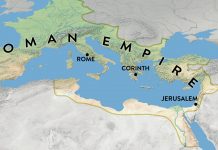“History shows how surpassingly difficult it is for Christians not to forget Christ,” says Professor Chris Green[1]. Forgetting does not mean losing sight of His existence, but rather losing sight of His way of being, His values, and His way of relating to those around Him.
Jesus remains unique and unrepeatable but at the same time the supreme model of life and faith for all—astonishingly distant and yet unexpectedly close to each of us. Learning to relate to people from His perspective can be not only an exercise in rediscovery, but also a way of rediscovering lost happiness and joy. For even if we do not agree with Alfred Adler’s conclusion that all the problems in our lives are relational, we must recognise that most of them are.
A double perspective
The way Jesus viewed human beings is surprising and sometimes paradoxical. They are the ones He taught to pray by saying “Our Father”, the ones He “loved to the end”, the ones for whom He prayed for forgiveness in the last moments of His life, but also the ones He compared to foxes, addressed as “fools and blind”, or even compared to “dogs” and “pigs” who do not value what is sacred (Matthew 6:9-13; John 13:1; Luke 23:34; 13:32; Matthew 23:19; 7:6). Faced with such a complex and contrasting picture, one can’t help but wonder: what did Jesus think of people?

Even a cursory reading of the Gospels reveals that Jesus related to people primarily as God the Creator. His references to the creation story and the apostle John’s statement that “through Him all things were made” (John 1:3) show that Jesus believed in the historicity of the creation account in the book of Genesis. His words and even His gestures (“He breathed on them”—John 20:22) make it clear that He knew that human beings were the creation of His hands. That is why the decision to incarnate is so full of meaning and humility. Although He was the Creator, He became human so that humanity might once again feel the touch of God from which it had once fled in Eden. Dressed, not in His former glory, but in the clothes of an anonymous carpenter, He came to walk the muddy roads of Palestine in search of the lost Adams hidden under the fig leaves of their own prejudices and sins.
In the way Jesus looked at people, instead of seeing the wisdom of the Creator, we see the goodness of one who was like them, the love of a brother, the care, the gentleness and the faithfulness.
This is the reason why He said “Love each other as I have loved you” (John 15:12).
How did He love us?
Let’s explore His view of people through some of the paradoxes we find in the Gospels, which capture the complexity of His way of reaching out to people and showing them His love.
Although He knew everything about people, He was still amazed by what He noticed in them. The Gospel writers often say of Jesus that He knew everything about the people He met. John, for example, tells of the enthusiastic crowds who joined the disciples of Jesus at the first Passover feast the teacher attended after being baptised: “But Jesus would not entrust Himself to them, for He knew all people. He did not need any testimony about mankind, for He knew what was in each person” (John 2:24, 25). Statements like this occur frequently in John: Jesus knew Nathanael, He knew how many husbands the Samaritan woman had, or who wanted to betray Him. But while the evangelists had no doubt about His ability to know everything about everyone He met, they also record two occasions when Jesus was amazed, as we all are. Jesus was amazed at the lack of faith of the people of Nazareth and at the faith of the Roman centurion who was sure that Jesus could heal his servant with a single word spoken from afar (Mark 6:6; Matthew 8:10).
It seems hard for us to understand that for someone who knows everything about everyone, there can still be reactions from people that cause Him amazement, but these help us to see even more the depth of His love. Here is a Jesus who knows everything about Judas but accepts him among His closest collaborators anyway. Such a Jesus preaches and does good to people who will one day condemn Him to death, and continues to be amazed (pained, hardly reconciled) by their stubbornness or fascinated (delighted) by their faith. This amazement brings Him closer to us and reveals the astonishing passion He has for human beings. Jesus loves people so much that their small gestures of faith still evoke in Him an emotional response akin to pleasant surprise, and although He knows them so well, He continues to experience their refusal to respond to His goodness as an incomprehensible gesture. Nevertheless, He continues to show them compassion and kindness.
Jesus overturns social customs when He chooses people. This is another paradox in the way He treats those around Him. He doesn’t take an adult and put him in the midst of children to be an example to them, but he takes a child and puts him in the midst of adults. He does not scold the children who follow Him, but scolds the disciples who do not let them bother Him. Jesus gave the greatest gift to all children when He chose to be incarnated not in an adult, as Adam was, but in a child. Can you imagine Jesus at three, five or seven years old? At the age of twelve, when He went to the temple and talked to the wise men, He didn’t go with the attitude of someone who knew everything, but as was appropriate for His age…with questions. He must have had such charm and warmth that the children could listen to Him for hours without getting bored. He must have conveyed serenity and joy, readiness to help those around Him, sensitivity to their needs, discretion, and loyalty. He was never bothered by the presence of people, nor by their sincere or hidden questions.
When He chose the twelve apostles, He looked for people whose character we could all identify with. Ambitious, volcanic, contemplative, enthusiastic, quiet, perfectionist—we can all see ourselves in their way of being. And He loved each of them in their own way. He let John rest his head on His bosom, Peter walk on water, Thomas touch His wounds, and even let Judas give Him the kiss of betrayal. And not just them. He did the same with Paul, whom He met on the road to Emmaus and made an apostle to the Gentiles. Jesus knew not only who the people before Him were, not only their sins and the failings that embittered their lives, but also what they could become through His power and the people their transformed lives could change and bring closer to Him.
Jesus was close to people, but he also knew how to keep a distance. Jesus, who is said to have “loved Martha and her sister” (John 11:5), who reveals Himself for the first time to Mary on the morning of the resurrection, who has a group of women as supporters of His work (Luke 8:1-3), surprises the disciples at the well of Sychar when they see Him “talking with a woman” (John 4:27). But He was never accused by His enemies of improper behaviour towards a woman. He was a moral standard for all who knew Him.
In the Gospels, Jesus is close to everyone, but leaves enough space for everyone to feel free to choose, even to say no, as Judas, Pilate, and many of His followers did.
The fact that there are repeated episodes of the disciples being called may indicate that they were called by Jesus more than once. This would explain, for example, why the rich young man, despite being told in the text that Jesus “loved him” (Mark 10:21), went away without responding to the invitation of Jesus.
He who invented freedom offered it to everyone He met, with the same responsibility as in Eden, and died precisely to guarantee human beings the freedom to say yes or no. This is why He prayed on the cross: “Father, forgive them, for they do not know what they are doing” (Luke 23:34), and the first to respond to this prayer was the centurion who acknowledged Him as the Son of God. By virtue of this freedom, He chose to remain silent in the face of the false witnesses, the priests, and the scribes who raged against Him, and for this very reason, after the Resurrection, He avoided Pilate, Herod, Anna, and Caiaphas. How would these four have walked through Jerusalem, knowing that they could meet Him at any moment? Imagine how much they would have “prayed” that He would not pass them by and greet them discreetly. Jesus granted their wish.
“Jesus loved…” This is perhaps the best way to describe the way He interacted with the people around Him. We might want to read the whole Gospel in this note, which is so difficult to understand—Jesus loved the busy Martha, the shy Lazarus, Mary with her complicated past, Peter, John, Thomas, and even Pilate, Herod, the rich young man, and Judas. So obvious was this about Him that they mockingly called Him the “friend of tax collectors and sinners” (Matthew 11:19). It only hurt Him that they didn’t want Him to be their friend as well. Because He loved them so much, He told them all the truth, sometimes in tears, sometimes with firmness, but always with responsibility and grace.
And one more thing: He never gossiped. If you find that inspiring, let’s follow His example and love like He loved!
Adrian Neagu believes that the way Jesus treated those around Him is the recipe for happy and fulfilling relationships.

















